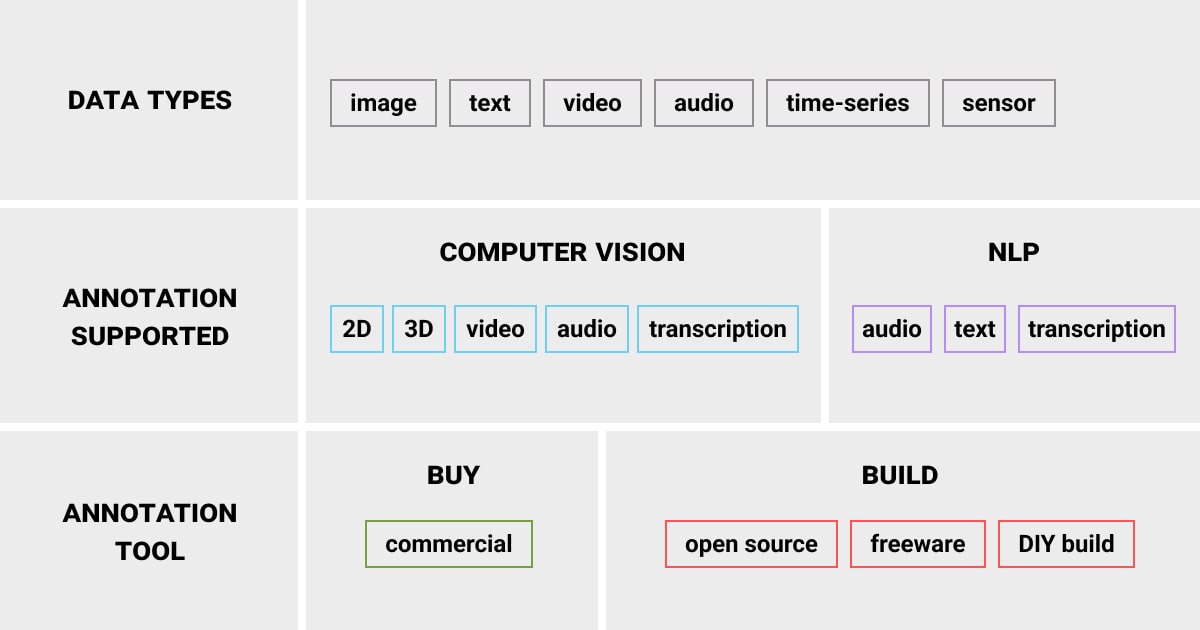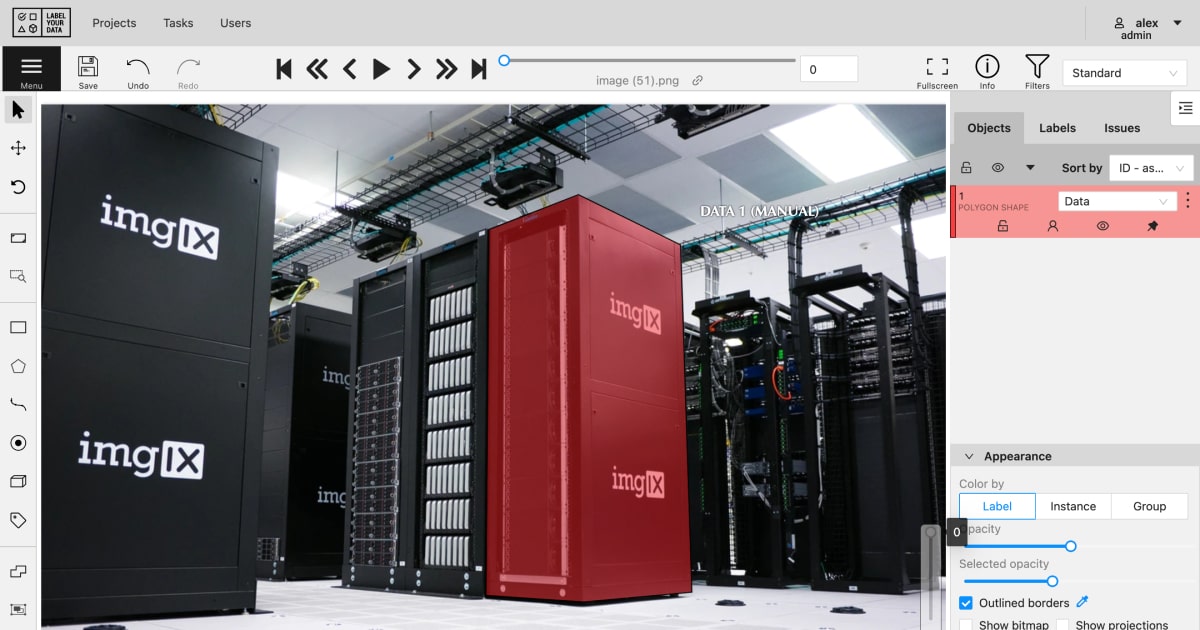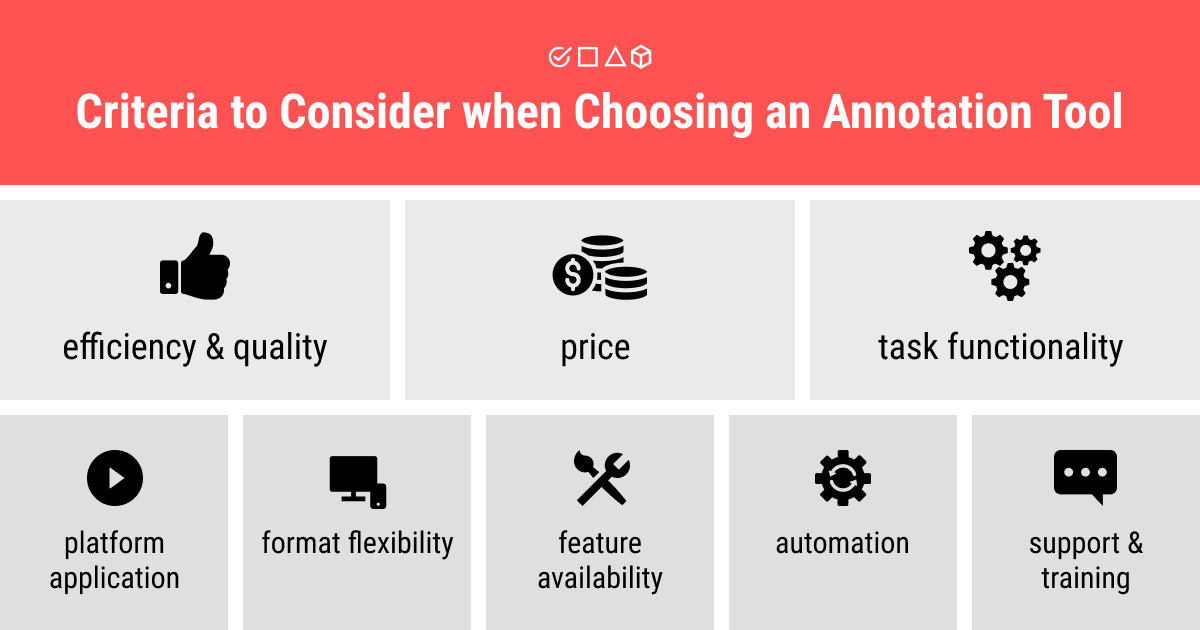Data Annotation Tools: Comparing Top Solutions
Table of Contents
- TL;DR
- Top Use Cases for Data Labeling Tools
- Key Features to Look for in Data Annotation Tools
- Overview of Top Data Annotation Tools in 2025
- Open Source vs Commercial Data Annotation Tools
- How to Compare Annotation Tools for Your ML Project
- When Data Labeling Tools Aren’t Enough
- About Label Your Data
- FAQ

TL;DR
- Data annotation tools are software platforms that enable teams to label and structure raw data for ML model training.
- Key features to consider include scalability, automation, workflow management, and data security.
- Choose a tool based on your project’s data type, budget, and complexity.
- Common use cases for annotation tools include handling large datasets, supporting complex labeling tasks, and enabling team collaboration.
- In some cases, outsourcing data annotation may be more efficient, especially for high-volume or specialized projects.
Top Use Cases for Data Labeling Tools
The world today generates more data than ever, and data annotation is one of the most important steps in the process of making that data usable for machine learning. Yet, there are points in any ML project when data annotation tools go from helpful to essential.
Here’s when you’ll know it’s time to bring them in:
Your Data Volume is Exploding
Manually labeling large datasets takes too long and eats up resources. When data is piling up faster than your team can label it, an annotation tool lets you keep up without losing quality.
You’re Struggling to Keep Labels Consistent
If your model’s performance is slipping, it could be due to inconsistent data labels. Annotation tools help you standardize labeling, ensuring accuracy and reliability across your dataset.
You Have Specialized Data Needs
For complex data—like medical images or geospatial annotation—basic annotation isn’t enough. You’ll need a tool with advanced features designed to handle your unique data types.
Your Team is Growing
As more people get involved, it’s easy for labeling tasks to become chaotic. Annotation tools with project management features help you organize tasks, manage versions, and keep everyone on the same page.
Security and Compliance are Critical
If you’re dealing with sensitive data, like patient records or financial info, security is non-negotiable. Text or image annotation tools with compliance features help you meet regulatory requirements and protect data privacy.
Smart automation capabilities, such as AI-assisted labeling, allow annotation tools to pre-label data based on learned patterns, which is invaluable when dealing with large datasets.
Selecting the best data annotation tools for AI helps you overcome common bottlenecks in ML workflows. But how should you do it right?
Key Features to Look for in Data Annotation Tools

Choosing the right tool depends on your specific project needs and the type of data you’re working with. Some data labeling tools excel at managing massive datasets for image recognition, while others offer specialized features for labeling complex data, like audio for automatic speech recognition or 3D point clouds.
The core features to prioritize:
Scalability and Flexibility
A tool must handle various data types—text, images, video, or even 3D point clouds—depending on the project’s scope. This flexibility is key to adapting the tool as project needs evolve.
Automated Annotation Options
Tools with AI-assisted labeling capabilities can speed up repetitive tasks and improve labeling accuracy, reducing manual workload and helping teams stay focused on more complex tasks.
Collaboration and Workflow Management
Built-in project management and collaboration tools streamline communication, making it easier to coordinate across teams, assign tasks, and track progress, especially in larger or remote teams.
Integration with ML Pipelines
Seamless integration with ML platforms (via APIs or direct compatibility) allows labeled data to flow directly into model training workflows, reducing the time and effort needed to prepare data for analysis.
Data Security and Compliance
For projects involving sensitive data, tools that offer advanced security and compliance features (e.g., encryption, access controls) are essential. This is especially relevant in regulated industries like healthcare or finance.
Overview of Top Data Annotation Tools in 2025
With various AI data annotation tools available, each offers unique features suited to different ML project needs. We’ve prepared a breakdown of the top tools, where we highlighted their key features, benefits, and use cases to help you find the right fit for your ML workflow.
But before you label anything, you may need to collect the right datasets. Check our post on data collection tools to explore your options.
Label Your Data
Label Your Data offers a self-serve data annotation platform designed for teams that need high-quality labeled data without long onboarding cycles or minimum commitments. The platform supports computer vision data, with features like a cost calculator, free pilot, instruction generator, and full API access. You can monitor progress, manage team roles, and download results from a single dashboard.
- Type: Commercial
- Key Features: No-commitment sign-up, free pilot, instruction templates, cost calculator, API and team access
- Pros: Fast setup, supports multiple annotation types, great for ML teams with tight timelines
- Cons: Currently supports computer vision data only
- Best Use Cases: Startups, researchers, and ML teams needing flexible, on-demand annotation at scale
CVAT (Computer Vision Annotation Tool)
CVAT is a popular open-source annotation tool for computer vision, offering robust capabilities for both image and video labeling. Known for its flexibility, CVAT supports a wide range of annotation tasks, including bounding boxes, semantic segmentation, and object tracking. This tool is frequently used by academic and industry teams who need reliable, detailed annotations for complex computer vision projects.
- Type: Open-source.
- Key Features: Semantic segmentation, bounding boxes, object tracking.
- Pros: Flexible, robust features for complex annotations; strong open-source support.
- Cons: Setup and learning curve can be challenging; limited automation features.
- Best Use Cases: Computer vision projects requiring high-quality image and video annotations.
Labellerr
Labellerr is designed for teams handling large datasets that require high accuracy across complex data types, such as text, images, and videos. Known for its AI-powered labeling and advanced collaboration features, Labellerr is best suited for enterprises and organizations where precision is crucial and projects involve cross-functional teams.
- Type: Commercial.
- Key Features: AI-powered labeling, real-time collaboration, multi-format support.
- Pros: Supports complex data types, integrates easily with ML pipelines.
- Cons: Higher cost for large projects.
- Best Use Cases: Enterprises needing high-accuracy labeling across text, image, and video datasets.
Labelbox
Labelbox offers a comprehensive annotation platform with automated labeling, making it ideal for large-scale ML projects. With robust project management and a user-friendly interface, this tool suits teams looking for an all-in-one annotation solution that’s scalable across different data types.
- Type: Commercial.
- Key Features: Automated labeling, project management, multi-user workflows.
- Pros: User-friendly interface, strong API integration.
- Cons: Limited free version; some advanced features require custom pricing.
- Best Use Cases: Teams needing flexible annotation for various data types in large-scale ML projects.
SuperAnnotate
SuperAnnotate is tailored for computer vision projects, especially those involving high volumes of image and video data. It’s known for its powerful AI-assisted image segmentation and automated quality checks, making it a go-to for teams focused on maintaining high labeling standards for visual data.
- Type: Commercial.
- Key Features: AI-assisted image segmentation, annotation automation, video labeling.
- Pros: Excellent for image and video projects, with automated quality checks.
- Cons: Limited support for non-visual data.
- Best Use Cases: Computer vision projects requiring precise and high-volume annotations.
Appen
Appen combines data annotation with human-in-the-loop validation, offering a platform geared toward large enterprises that need scalable human-verified annotations. It’s ideal for projects that demand a blend of automation and human oversight to ensure top-notch accuracy.
- Type: Commercial.
- Key Features: Robust data annotation platform, human-in-the-loop validation.
- Pros: Scalable, high-quality human review options.
- Cons: Slower setup for small teams.
- Best Use Cases: Enterprises needing scalable human-verified annotations, especially for NLP and complex data.
V7
V7 is a powerful tool for image and video annotation, built with features like automation and real-time collaboration. Known for seamless integration with ML workflows, it’s suited for large teams working with high-volume data in computer vision.
- Type: Commercial.
- Key Features: Automation for computer vision, real-time collaboration, quality control.
- Pros: Advanced tools for image and video annotation; seamless integration.
- Cons: Custom pricing may not suit smaller budgets.
- Best Use Cases: Large teams with complex image/video data requiring automation.
Amazon SageMaker Ground Truth
Amazon SageMaker Ground Truth is a fully managed data labeling service that integrates directly with AWS, making it an ideal choice for teams already working within the AWS ecosystem. It’s designed for large-scale projects, especially when teams need a secure and scalable solution.
- Type: Commercial.
- Key Features: Built-in ML model integration, managed labeling workforce.
- Pros: Native AWS integration, suitable for large projects.
- Cons: AWS reliance may not fit all tech stacks.
- Best Use Cases: Teams already using AWS for ML, handling large datasets with scalable needs.
Roboflow
Roboflow simplifies image annotation with AI-powered tools, making it accessible for startups and smaller teams. With a focus on computer vision, it’s well-suited for teams needing quick setup and intuitive features without the complexity of larger platforms.
- Type: Commercial.
- Key Features: AI-powered labeling, computer vision focus, fast setup.
- Pros: User-friendly, accessible for smaller teams.
- Cons: Limited NLP features.
- Best Use Cases: Computer vision projects for startups and small teams with image data needs.
A top-notch annotation tool, in my view, needs a strong layered-visualization feature... It lets me catch inconsistencies or overlaps, making the process faster and way more reliable.
Dataloop
Dataloop combines workflow automation and multi-format support, making it a flexible choice for teams that manage diverse data. It’s ideal for projects where end-to-end annotation workflow management is critical.
- Type: Commercial.
- Key Features: Workflow automation, annotation customization, multi-format support.
- Pros: Flexible data support; built-in project management.
- Cons: Higher costs for advanced features.
- Best Use Cases: Teams needing end-to-end annotation workflow management for diverse data types.
Scale AI
Scale AI specializes in high-accuracy, scalable data annotation services, making it ideal for large enterprises with strict quality requirements. The platform emphasizes enterprise-grade support, with a strong focus on security.
- Type: Commercial.
- Key Features: High-accuracy data labeling, scalability, human review.
- Pros: Enterprise-grade support and security.
- Cons: Premium pricing model.
- Best Use Cases: Large enterprises needing quality-focused, scalable annotations.
Keylabs
Keylabs provides affordable, flexible data annotation with customizable workflows, making it suitable for mid-size teams that need robust annotation capabilities without enterprise pricing.
- Type: Commercial.
- Key Features: AI-assisted labeling, easy-to-use interface, customizable workflows.
- Pros: Affordable, flexible options for mid-size teams.
- Cons: Limited support for very large datasets.
- Best Use Cases: Mid-sized teams working with visual data in a collaborative environment.
Kili
Kili is a versatile tool supporting various data types and customizable workflows, making it a good fit for research and smaller commercial projects. Its flexibility allows teams to adjust workflows for different data and project requirements.
- Type: Commercial.
- Key Features: Multi-data type support, customizable workflows, collaboration tools.
- Pros: Versatile and affordable for small to mid-size projects.
- Cons: Limited automation compared to some competitors.
- Best Use Cases: Academic and small research teams needing flexible, multi-format support.
Label Studio
Label Studio is an open-source tool known for its adaptability and strong community support. It’s ideal for teams needing a customizable, cost-effective solution for varied data types, particularly in research environments.
- Type: Open-source.
- Key Features: Open-source, customizable, support for multiple data formats.
- Pros: Free and highly adaptable; strong community support.
- Cons: Limited support without technical setup.
- Best Use Cases: Research and academic projects needing a free, adaptable tool.
LabelImg
LabelImg is a free, open-source graphical image annotation tool that lets you label images with bounding boxes. It’s widely used for for object detection tasks and is especially useful for teams looking for a lightweight, no-frills solution. Now maintained by the Label Studio community (HumanSignal), it continues to support XML (Pascal VOC) and YOLO formats, making it compatible with many ML workflows.
- Type: Open-source
- Key Features: Bounding box annotation, Pascal VOC and YOLO format support, Qt-based interface
- Pros: Simple setup, minimal dependencies, keyboard shortcuts for fast labeling, maintained by Label Studio
- Cons: Limited to bounding boxes; lacks support for polygons, segmentation, or complex workflows
- Best Use Cases: Basic image annotation projects focused on object detection with bounding boxes
QGIS
QGIS (Quantum Geographic Information System) is a popular open-source tool for geospatial data annotation and analysis, ideal for projects involving geographic and mapping data. With capabilities for orthomosaic, 2D, and 3D data annotation, QGIS is widely used in fields like environmental science, urban planning, and GIS-based research. It supports extensive plugins, allowing users to customize the tool to suit specific project requirements.
- Type: Open-source
- Key Features: Geospatial and orthomosaic annotation, plugin support, 2D and 3D data compatibility.
- Pros: Free, customizable, and excellent for geospatial and 3D tasks.
- Cons: Has a steep learning curve, limited non-geospatial support, and minimal automation.
- Best Use Cases: Mapping, environmental analysis, urban planning, and GIS-based data projects.
Encord
Encord is a data development platform optimized for computer vision projects, supporting both video and image data with annotation types like bounding boxes and semantic segmentation. With collaborative annotation, built-in QA, and API integration, Encord ensures efficient, accurate labeling for complex projects.
- Type: Commercial
- Key Features: Intuitive interface, collaborative annotation, built-in QA tools, API integration.
- Pros: Supports advanced annotation types and simultaneous user collaboration.
- Cons: Primarily focused on image and video data.
- Best Use Cases: Computer vision projects requiring high annotation accuracy and team collaboration.
BasicAI
BasicAI Cloud is a cloud-based platform ideal for computer vision and 3D data annotation. It supports complex annotations, real-time collaboration, and automated quality checks, making it a strong choice for autonomous driving and robotics. Its seamless ML framework integration and AI-assisted labeling further enhance its efficiency, making BasicAI Cloud a preferred choice for projects that demand high-quality, structured datasets.
- Type: Commercial
- Key Features: Real-time collaboration, automated quality checks, 3D sensor fusion support.
- Pros: Excels in handling 3D data, ideal for autonomous driving projects.
- Cons: Primarily designed for computer vision tasks.
- Best Use Cases: Autonomous driving and robotics projects that require precise 3D data annotation.
Open Source vs Commercial Data Annotation Tools

ML teams often face a critical decision: invest in a commercial solution or rely on open source data annotation tools. The right choice depends on your scale, security needs, and whether you’re backed by a data annotation company or building in-house.
| Attribute | Commercial labeling tools | Open-Source labeling tools |
| Cost | Subscription or pay-per-use; premium pricing | Free or low-cost; budget-friendly |
| Support | Vendor support, regular updates | Community-driven, limited support |
| Features | Advanced (automation, QA, integrations) | Basic to moderate; customizable by developers |
| Scalability | Built to scale, suited for enterprise needs | Can scale with added setup |
| Security | Strong compliance for regulated industries | Depends on configuration |
| Best Fit | Enterprises, high-volume projects | Academic, small teams, cost-sensitive projects |
How to Compare Annotation Tools for Your ML Project

After reviewing data annotation tools and their features, the next step is evaluating how they fit your workflow. ML teams should consider:
Once you’ve reviewed the features of each platform, it’s time to decide which one actually fits your workflow. For some ML teams, that means choosing a flexible interface that supports internal workflows. For others, it means skipping tools altogether and turning to data annotation services that handle the labeling end to end. Your final pick should match your project’s size, data types, and quality expectations—without slowing down your pipeline.
An effective annotation tool has low latency, automates repetitive tasks, and gives you tools to handle edge cases. It should support smooth, fast navigation across large datasets, enabling teams to work without slowdowns.
Data Type Compatibility
Not all tools support multimodal projects. For image/video-heavy work, look to V7 or SuperAnnotate. For geospatial, QGIS is purpose-built. NLP tasks are better served by Appen or Labellerr.
Scalability
If you’re labeling at scale or running iterative model training, tools like Dataloop, Labelbox, or SageMaker offer strong project orchestration and API access.
Automation & QA
Need pre-labeling or consensus review? V7, SuperAnnotate, and Scale AI have built-in automation. CVAT and Label Studio require manual setup.
Team Structure
Solo researcher? Open source like LabelImg or CVAT might be enough. Mid-sized or cross-functional teams? Go with tools offering role-based access and collaboration features.
Security Requirements
For healthcare, finance, or defense projects, choose platforms with SOC 2 or ISO 27001 compliance. Most commercial tools cover this; open-source will require custom security layers.
Project Type
| Project Type | Key Features Needed | Recommended Tools |
| NLP | Named Entity Recognition, Text Classification, Audio Transcription | Labellerr, Appen, Labelbox, Kili, LightTag, Scale AI, Label Studio |
| Basic Computer Vision | Bounding Box Annotation, Simple Interface, Hotkeys | Label Your Data, LabelImg, Roboflow, Label Studio |
| Advanced Computer Vision | 3D Point Cloud, Object Tracking, Segmentation | Label Your Data, CVAT, SuperAnnotate, V7, Amazon SageMaker Ground Truth, Encord, Dataloop, BasicAI, Scale AI |
| Geospatial/Mapping | Orthomosaic, 2D/3D Geospatial Annotation | Label Your Data, QGIS, Pix4D, Scale AI |
| Multi-Data Type Projects | Real-Time Collaboration, Workflow Automation, API Integrations | Label Your Data, Labellerr, Dataloop, Labelbox, Scale AI, Appen, SuperAnnotate, BasicAI |
Let this act as your filter before committing to a tool. The right fit depends not just on features but on your actual ML pipeline.
When Data Labeling Tools Aren’t Enough
While annotation tools solve many challenges, certain projects benefit more from outsourcing to professional data annotation services. Here’s when it adds value:
Large-Scale Projects
Handling massive datasets in-house can be overwhelming. Outsourcing provides a dedicated workforce to manage high-volume projects efficiently.
Complex and Specialized Data
Projects like medical imaging or LLM fine tuning often need domain-specific expertise, which professional services can supply.
Stringent Quality Requirements
For projects demanding high accuracy, external services offer rigorous QA processes to ensure data reliability.
Resource Constraints
Limited resources make scaling in-house challenging. Outsourcing meets deadlines without straining internal teams.A professional data annotation company, like Label Your Data, offers the scalability, expertise, and quality that tools alone may not provide, making it ideal for teams with unique demands or limited resources.
About Label Your Data
If you choose to delegate data annotation, run a free data pilot with Label Your Data. Our outsourcing strategy has helped many companies scale their ML projects. Here’s why:
Check our performance based on a free trial
Pay per labeled object or per annotation hour
Working with every annotation tool, even your custom tools
Work with a data-certified vendor: PCI DSS Level 1, ISO:2700, GDPR, CCPA
FAQ
What is a data annotation tool?
A data annotation tool is software designed to label datasets, transforming raw data (such as text, images, or video) into structured data that can be used to train machine learning models. These tools streamline the labeling process, enhance accuracy, and often offer features like automation, collaboration, and quality control to ensure high-quality labeled data for AI applications.
What is the best annotation tool?
The best annotation tool depends on your specific project requirements, including data type, volume, and budget. Leading options include Labelbox and SuperAnnotate for robust, commercial-grade annotation, while open-source tools like CVAT offer flexibility for teams with custom needs. Each tool has unique strengths, so it’s essential to choose one that aligns with your workflow.
Should I use a data annotation tool or outsource data labeling services?
When managing high-volume, complex projects or meeting strict quality standards, outsourcing may be more efficient. However, if you need full control over the process or have a smaller, well-defined dataset, an in-house annotation tool could be the better choice.
What is a data labeling tool?
A data labeling tool is software used to annotate raw data (like images, video, text, or audio) so it can be used to train machine learning models. These tools help streamline the annotation process by providing workflows, quality checks, and automation features.
What is the difference between V7 and CVAT?
V7 is a commercial, cloud-based platform designed for enterprise-scale computer vision projects with automation and collaboration features. CVAT (Computer Vision Annotation Tool) is an open-source tool, offering flexibility and control for teams that prefer to host and manage their own annotation workflows.
Written by
Karyna is the CEO of Label Your Data, a company specializing in data labeling solutions for machine learning projects. With a strong background in machine learning, she frequently collaborates with editors to share her expertise through articles, whitepapers, and presentations.





